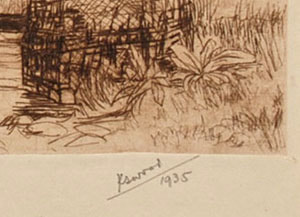
Karl Salsbury Wood (1888-1958)
Karl Salsbury Wood was born at King’s Newton near Melbourne in Derbyshire in 1888. As the historian Dr Tony Shaw* noted, ‘He was self-educated and wore his learning like a badge, always ready with a literary quotation, and always eager to converse about music, art or books. He could be pompous and self-opinionated, but this was just part of the palette of his personality.’
Obsession was another facet of his personality. Following service in the First World War, Wood lived in Gainsborough, Lincolnshire where he taught music and art. By the late 1920s, he had developed a passion which was to occupy his time and his art for the rest of his life. Wood’s self-imposed quest was to paint all the extant windmills in Britain. The ultimate goal was a comprehensive book, The Twilight of the Mills, which Wood planned to write and illustrate.
The task, mammoth in scope and somewhat haphazard in execution (Wood planned to visit each of the windmills by bicycle facilitated by train trips, where necessary) got off to a promising start. In January 1933, the Retford, Worksop, Isle of Axholme and Gainsborough News reported that Wood had by that date cycled thousands of miles and painted 450 windmills (over a quarter of the 1,650 mills Wood estimated were still standing).
Wood continued to paint and etch windmills for the rest of his life. The venture was ruinously derailed in 1951 when the homosexual Wood was convicted of gross indecency and sentenced to four years imprisonment. According to Tony Shaw, ‘it has been said that the experience destroyed him; his spirit was broken and the shame rendered it impossible for him to return to Gainsborough.’
Wood spent his final years far from Lincolnshire at Pluscarden Abbey near Elgin in Scotland. He continued to paint (his last recorded windmill painting dates from 1956) but the task he’d set himself almost thirty years earlier remained unfinished at the time of his death, from tuberculosis, in 1958.
In total, Wood painted around 1,400 windmills. The Twilight of the Mills was never published.
*This article draws heavily on Dr Shaw’s comprehensive piece on the life and art of Karl Salsbury Wood which can be read in full here.
Collections
Cheltenham Art Gallery and Museum
Lincolnshire Museums
Private Collections
Literature
Buckman, David, Artists in Britain Since 1945 (2006)
Johnson, J and Greutzner, A, British Artists 1880-1940 (1999)
Karl Salsbury Wood was born at King’s Newton near Melbourne in Derbyshire in 1888. As the historian Dr Tony Shaw* noted, ‘He was self-educated and wore his learning like a badge, always ready with a literary quotation, and always eager to converse about music, art or books. He could be pompous and self-opinionated, but this was just part of the palette of his personality.’
Obsession was another facet of his personality. Following service in the First World War, Wood lived in Gainsborough, Lincolnshire where he taught music and art. By the late 1920s, he had developed a passion which was to occupy his time and his art for the rest of his life. Wood’s self-imposed quest was to paint all the extant windmills in Britain. The ultimate goal was a comprehensive book, The Twilight of the Mills, which Wood planned to write and illustrate.
The task, mammoth in scope and somewhat haphazard in execution (Wood planned to visit each of the windmills by bicycle facilitated by train trips, where necessary) got off to a promising start. In January 1933, the Retford, Worksop, Isle of Axholme and Gainsborough News reported that Wood had by that date cycled thousands of miles and painted 450 windmills (over a quarter of the 1,650 mills Wood estimated were still standing).
Wood continued to paint and etch windmills for the rest of his life. The venture was ruinously derailed in 1951 when the homosexual Wood was convicted of gross indecency and sentenced to four years imprisonment. According to Tony Shaw, ‘it has been said that the experience destroyed him; his spirit was broken and the shame rendered it impossible for him to return to Gainsborough.’
Wood spent his final years far from Lincolnshire at Pluscarden Abbey near Elgin in Scotland. He continued to paint (his last recorded windmill painting dates from 1956) but the task he’d set himself almost thirty years earlier remained unfinished at the time of his death, from tuberculosis, in 1958.
In total, Wood painted around 1,400 windmills. The Twilight of the Mills was never published.
*This article draws heavily on Dr Shaw’s comprehensive piece on the life and art of Karl Salsbury Wood which can be read in full here.
Collections
Cheltenham Art Gallery and Museum
Lincolnshire Museums
Private Collections
Literature
Buckman, David, Artists in Britain Since 1945 (2006)
Johnson, J and Greutzner, A, British Artists 1880-1940 (1999)